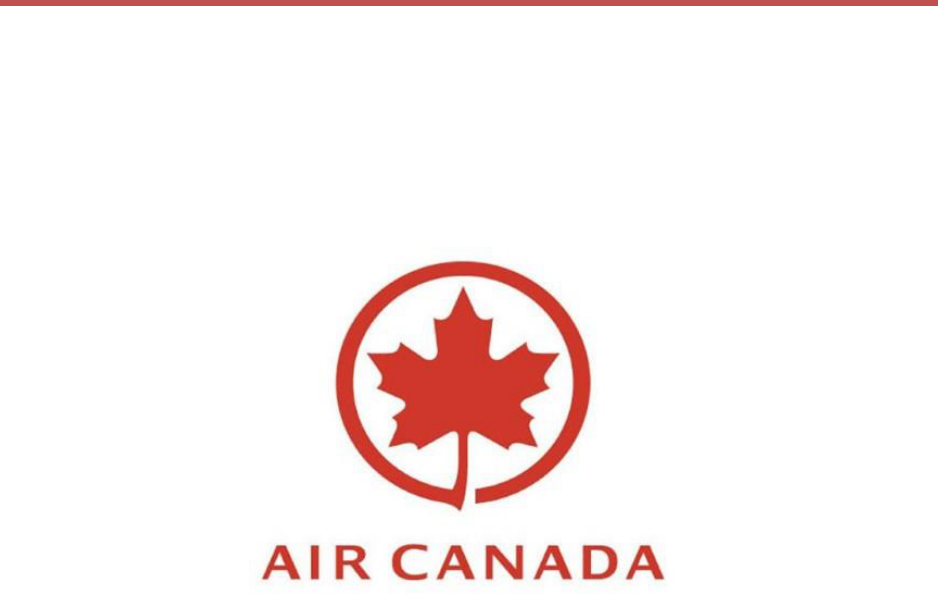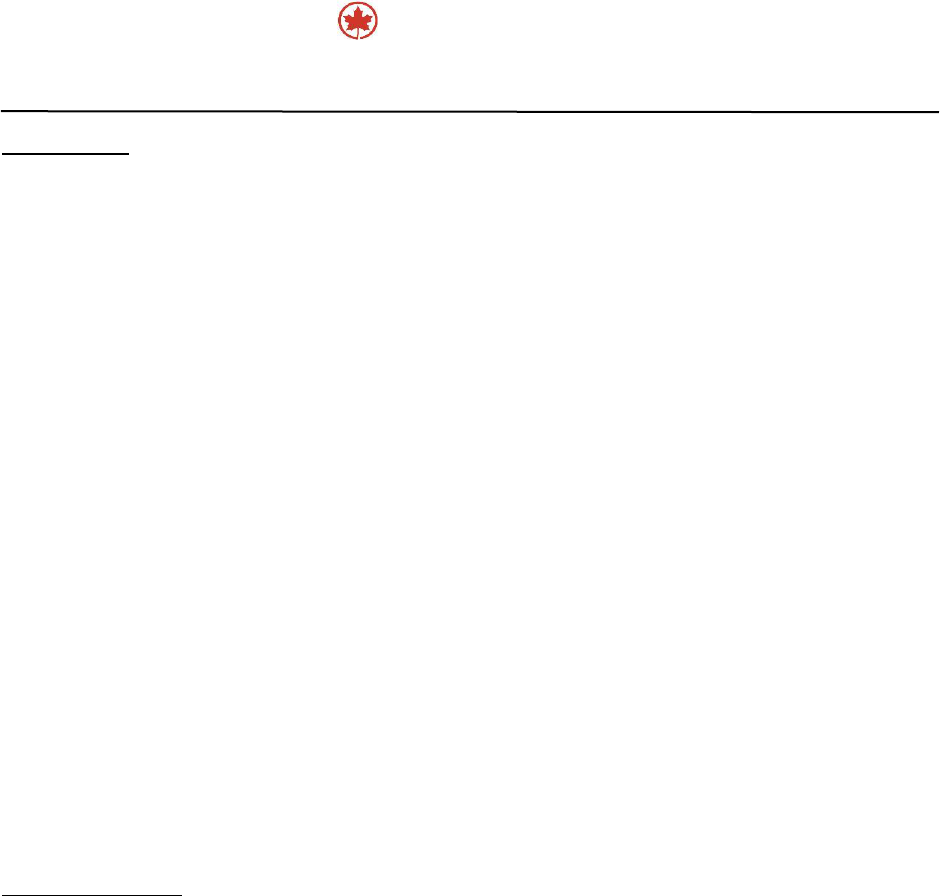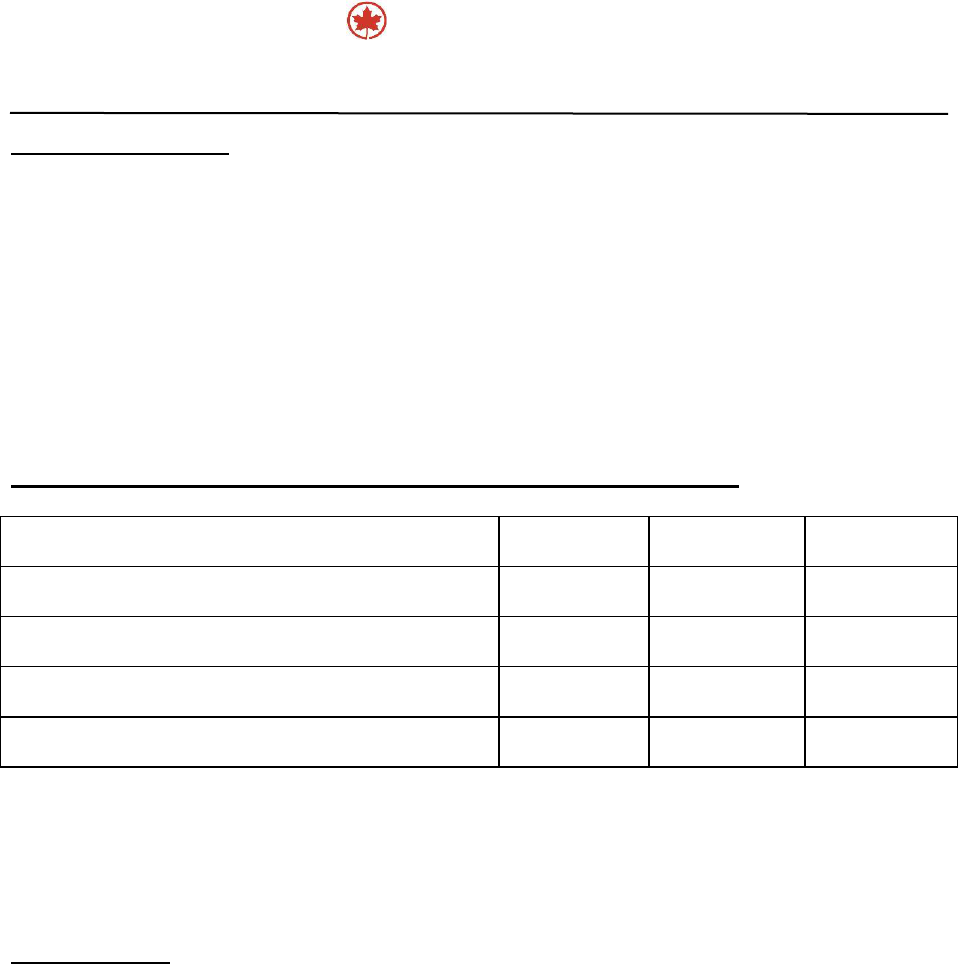
Air Canada
Case Synopsis
Professor: Jerry Sheppard
Course: BUS 478 D300
Submitted by Group E:
Jiamin Huo, Stacy Wang, Yanqing Ding, Victoria Hong
March 18, 2013

Air Canada Case Synopsis
Page 1 of 11
INTRODUCTION
Brief History
Air Canada is the flagship carrier and the largest airline company in Canada. Formally
named Tans-Canada Airlines, the airline was established in 1936 by Canadian federal
government. In 1988, Air Canada was privatized due to the deregulation of the Canadian airline
market. Then Air Canada acquired its largest rival and laid the foundation as the largest airline
company in Canada. Air Canada is a founding member of Star Alliance which flies to 1290
destinations in 189 countries by using a wide range model of aircrafts, such as Airbus A330,
A320 and Boeing 747, 767, 777. Also, Air Canada will begin operating Boeing 787s, which will
reduce the fuel and maintenance cost sharply. The largest hub for Air Canada resides at Toronto
Pearson International Airport, which handled 33.4 million passengers in 2011. Air Canada has its
headquarters in Montreal, and is also operating cargo transportation and providing vacation
packages to over 90 destinations. All this has led to a revenue of CA $10.2 billion in 2011
(About Air Canada, 2012).
Mission and Goals
Air Canada’s Mission is “Connecting Canada and the World” with its vision as “Building
loyalty through passion and innovation” (About Air Canada, 2012).
In order to achieve its mission, Air Canada has the following objectives:
To increase operating earnings and cash flow; Air Canada continues to focus its activities on
improving its financial performance while increasing its productivity and improving its cost
structure.
To embrace leadership, accountability and entrepreneurship.

Air Canada Case Synopsis
Page 2 of 11
To maintain a minimum unrestricted cash balance in excess of a target liquidity level of 15%
of 12-month trailing operating revenues regarding managing liquidity.
To minimize the generation of waste as well as the emission of carbon dioxide and other
greenhouse gases regarding Air Canada’s environmental concern (Air Canada: 2011 Annual
Report).
ENVIRONMENT
General Environment
As an international airline, opportunities and threats in the global environment largely
affect the strategies adopted by Air Canada. After the global financial crisis in 2001, the share
price of airlines and airplane manufacturers dramatically dropped due to decreased recreational
spending. The sovereign debt crisis in Europe has placed pressure on banks to tighten lending
conditions to households, which increased the probability of an adverse shock to the income of
Canadian. In addition, political unrest in the Middle East has caused oil prices to increase
steadily. Over the last 10 years, Canada has become a multicultural country because of increased
immigration. Cultural differences have created a variety of innovative ideas for businesses, but
have also increased management difficulty. Since more than 69.1 percent of Canada’s population
reside in metropolitan areas (2011 Census: Population and dwelling counts, 2012), Air Canada
has chosen to have landing spots in big cities in order to obtain more passenger traffic, and
consequently, market share. The Government of Canada has integrated regulations for the airline
industry, including the allocation of allowable fuel emission, and safety policy and the
regulations about advertising ticket price; but price competition is left to the discretion of the
industry. Moreover, the Federal corporate income tax rate has decreased from 19% in 2009 to 15%
in 2013, which provides an opportunity for the expansion of domestic businesses (Corporate

Air Canada Case Synopsis
Page 3 of 11
Income Tax, 2012). Oil price is one of the most significant factors affecting airline companies
business. Since fuel cost occupy one third of the total operating cost, the continuing high prices
will greatly affect Air Canada’s costs. Meanwhile, an increase in interest rate will sharply
increase the operating cost, since Air Canada has $3906 million in long term debt, which means
1% increase in interest rate will cost about $4 million payable to the creditors (Air Canada: 2011
Annual Report). By comparing the financial performance between Air Canada with its primary
competitor WestJet, even though Air Canada holds more than 80% market shares in Canada, it
has lost $249 million in 2011 while WestJet has made a profit of $148 million in 2011(Air
Canada: 2011 Annual Report).The employees in Air Canada is unionized which sometimes
probably will make protests, for example, they had a strike in 2012(Cassese, 2012). Efficiency
and customer satisfaction are important factors for the airline industry. Therefore, technological
innovation that can improve efficiency and customer satisfaction has the potential to better the
company’s profitability. Air Canada now uses Boeing 737 next generation planes for short-haul
routes and Boeing 777 and 787 for long-haul route, while its competitors still use older planes.
The new fleet is fuel efficient; require low maintenance cost, and low training cost. Thus,
technological improvement will provide Air Canada with sustainability. In terms of customer
satisfaction, Air Canada has developed technologies that increase customer convenience, such as
providing online check-ins and online purchases.
Industry Environment
Porter Five Forces analysis can provide a comprehensive understanding of the uncertain
aviation industry. The threat of new entrants is low because of economies of scale, likelihood of
retaliation, and high capital requirements; capital includes aircraft, and maintenance facilities.
The bargaining power of suppliers, which consist of aircraft manufacturers, fuel suppliers and

Air Canada Case Synopsis
Page 4 of 11
airports services suppliers, is medium to high due to oversupply in the aviation industry and strict
airport regulations. The bargaining power of customers is medium to high because of low
switching cost, undifferentiated products, and readily available information. The threat of
substitution is low since flying remains the best option for those travelling long distances, as it is
both faster and safer than competing modes of transportation. Air Canada’s major competitors
are broken into two segments, one is among traditional passenger carriers, and the other is that
between transport carriers. The latter, which is fierce, centers mainly on pricing and serviceable
routes.
Competitive Environment
Traditional carriers, Transat and Cathay Pacific, and cargo carrier, WestJet are among Air
Canada’s top competitors. Transat employs a vertical integration strategy, which has been
successful in making the airline the leader in the international tourism industry (Transat: 2011
Annual Report). Its goals are achievable because of its strength in distribution and cost
management, but weakened by its lack of alliances, and industry seasonality. Another competitor,
Cathay Pacific, is currently focusing on its Asia/Pacific growth with future emphasis on
sustainable air travel (Cathay Pacific: 2012 Annual Report). The ability to offer excellent
customer service abilities, and the creation of One World alliances are among Cathay Pacific’s
capabilities. Last, WestJet, a competitor in the cargo transportation segment, is focused on
profitable growth, and partnerships with future plans to expand in an environmentally friendly
manner. WestJet believes that its success in the past will be carried into the future. Its success
was and will be achieved by the airlines ability to offer low cost fares and enthusiastic customer
service (WestJet: Investors Relations, 2013). Although, it has made a trademark of its services, it
does acknowledge the lack of premium services.

Air Canada Case Synopsis
Page 5 of 11
Internal Resources & Capabilities
Air Canada’s resource can be separated into tangible resource and intangible. Physical
resource includes a mainline fleet of 205 aircraft comprise of 89 Airbus narrow-body aircraft, 56
Boeing and Airbus wide-body aircraft and 60 Embraer regional jets, and aircraft fuel and spare
parts. Financial resource consists of fuel derivatives; share forward contracts, interest rate swaps,
and Air Canada shares jump after pension extension on March 13, 2013. Technological resource
comprise of trademarks such as Air Canada’s logo and slogan. An intangible resource, HR, is
quite weak; employ relations have been stressful since IAMAW, which represents 8,600 ground
crew and mechanics at Air Canada, began labour dispute with Air Canada. Air Canada has been
very innovative; it has generated ideas that have quickly been transformed into products, such as
its mobile booking apps. Although, the airline has had a reputation for reliability and quality, it
has been decreasing due to its attempt at cutting cost. Air Canada has effective logistic
management techniques; the airline effectively controls the services provided to consumers in an
efficient manner that meets or exceeds customer expectations. Its information system allows
customers to check their flight status online, and through the use of Advanced Passenger
Information Systems (APIS), Air Canada can readily obtain customer data. Its Marketing
department effectively promotes deals, price-matching on the same routes, and advertises
through traditional and social media outlets. It also has excellent customer service. Furthermore,
Air Canada has an organizational structure that promotes efficiency, which results in reduced
cost. The organization is also highly innovative; it has transformed technological ideas into
products and services, such as lie-down beds, which was first offered by Air Canada. The
airline’s marketing; management and longstanding brand are among its core competencies.

Air Canada Case Synopsis
Page 6 of 11
CURRENT SITUATION
Financial Performance
Table 1 illustrates the financial performance of Air Canada over the past three years. Its
financial picture looks increasingly toxic. Operational costs are rising, with fuel charges
increasing by 27% in 2011 alone. Air Canada lost $249 million in 2011, compared with $24
million in 2010. Moreover, free cash flow has fluctuated dramatically over the past three years,
which could jeopardize the company’s sustainability.
Table 1: Three Years Financial Performance of Air Canada, 2009-2011
Financial Performance
2009
2010
2011
Operating Revenues
$9,739M
$10,786M
$11,612M
Net Operating Income (Loss)
(24M)
(24M)
(249M)
Free cash flow
(399M)
746M
366M
Adjusted net loss per share – Diluted
$ (0.18)
$ (0.58)
$ (0.72)
Source: adapted from Air Canada 2010 Annual Report and Air Canada 2011 Annual Report.
Retrieved from: http://www.aircanada.com/en/about/investor/reports.html
Current Strategy
Air Canada has been pursuing a business strategy that aims at improving its revenue
performance while increasing its productivity and improving its cost structure with the objective
of increasing operating earnings and cash flow. Specifically, Air Canada makes an effort to
leverage its strengths internationally, reducing costs, generating incremental revenues, focusing
on business travellers, and transforming its corporate culture with an emphasis on leadership,
accountability and entrepreneurship. Also, Air Canada has adopted an international powerhouse
strategy, which reflects its geographic advantage in the world with its hubs well-situated at

Air Canada Case Synopsis
Page 7 of 11
global crossroads used by travellers crossing both the Atlantic and Pacific (Air Canada: 2011
Annual Report).
STRATEGIC CHALLENGES
Maintain Cost Control
In order to offer the lower fares, Air Canada must be able to create cost effective contracts
with its suppliers and operate productively. Currently, there appears to be issues with cost
controls, since the airline has been experiencing negative profits for the past three years. The
challenge is whether or not Air Canada has the financial strength to invest in cost cutting
techniques, and whether it can do this while investing in environmental sustainability plans
similar to that of its competitors.
Increase Efficiency
In order to be the lowest price carrier, Air Canada has to develop a strategy that helps to
improve the efficiency of each value chain activity and to largely cut its costs. It is necessary to
focus on marketing and management activities, since both will contribute Air Canada’s success.
Manage Risks of Uncertain Interest Rate and Fuel Price
In addition to controlling cost by improving efficiency, a proper strategy of risk
management is important and challenging for Air Canada. The continuous increase in fuel prices
affects Air Canada’s ability to offer low prices; and uncertain interest rates largely affects
interest expense and the debt repayment.
Maintain Market Shares
Air Canada cannot relax their vigilance just because they have more than 80% market
shares in Canadian aviation business (Air Canada: 2011 Annual Report). Air Canada needs to

Air Canada Case Synopsis
Page 8 of 11
keep up with the latest technology and innovation in the aviation field. Also, strengthening R&D
will make it more competitive than other airline company.
Improving Financial Performance
By comparing the financial performance between Air Canada with its primary competitor
WestJet, even though Air Canada holds more than 80% market shares in Canada, it has lost $249
million in 2011, while WestJet has made a profit of $148 million in 2011(Air Canada: 2011
Annual Report). Therefore, trying to make a positive number on their income statement is the
first thing need to do in their future operation.

Air Canada Case Synopsis
Page 9 of 11
REFERENCES
Air Canada. (2012). About Air Canada. Retrieved from
http://www.aircanada.com/en/about/index.html
Air Canada. (2010). 2010 Annual Report. Retrieved from
http://www.aircanada.com/en/about/investor/documents/2010_ar.pdf
Air Canada. (2011). 2011 Annual Report. Retrieved from
http://www.aircanada.com/en/about/investor/documents/2010_ar.pdf
Cathay Pacific. (2012). 2012 Annual Report. Retrieved from
http://downloads.cathaypacific.com/cx/investor/annualreports/2011_annual-report_en.pdf
Cassese., M. (2012). Air Canada flights returning to normal after illegal strike. Retrieved from
http://www.thestar.com/business/2012/04/14/air_canada_flights_returning_to_normal_afte
r_illegal_strike.html
Deloitte. (July, 2012). Corporate Income Tax Rates. Retrieved from
http://www.deloitte.com/assets/Dcom-
Canada/Local%20Assets/Documents/Tax/EN/2012/ca_en_tax_Corporate_income_tax_rat
es_2009_2013_072012.pdf
History of Air Canada (2012). About Air Canada. Retrieved from
http://www.aircanada.com/en/about/index.html
PressTv. (February, 2013). Oil Prices Hit New High after Israeli Attack on Syria Research
Center. Retrieved from http://www.presstv.ir/detail/2013/02/01/286667/oil-rises-after-
israeli-attack-on-syria/
Statistics Canada. (February, 2012). 2011 Census: Population and dwelling counts. Retrieved
from http://www.statcan.gc.ca/daily-quotidien/120208/dq120208a-eng.htm

